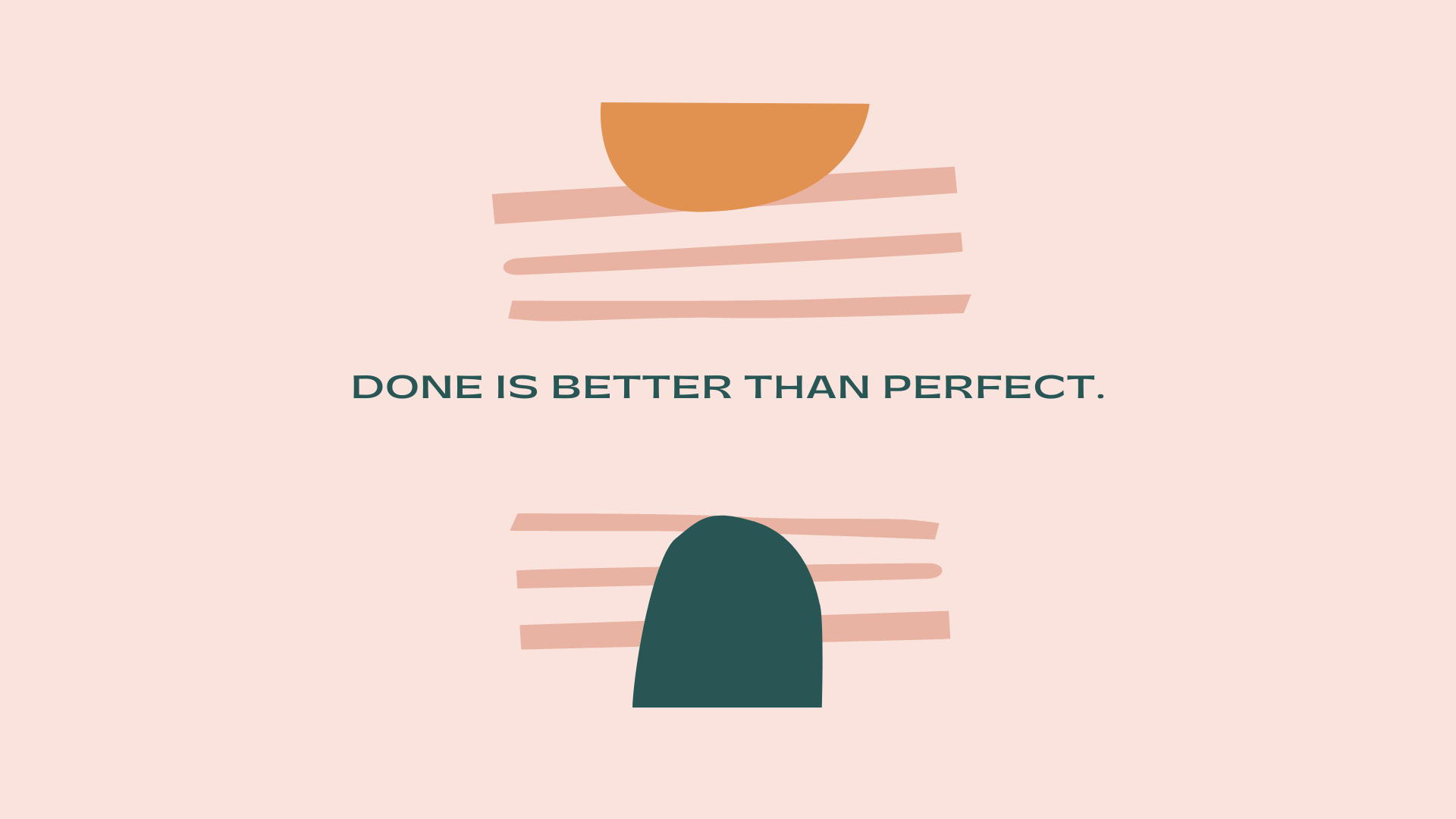Chase Progress, not Perfection
Chasing perfection only holds you back. Instead, focus on making small steps and steady progress. The quality of your output will be much higher. It’s only by doing that you get where you need to be
In praise of Quantity over Quality – Why you Should Strive for Progress, not Perfection
How many people love creating works of art with ceramic? Quite a few, I gather, if David Bayles and Ted Orland deem it the perfect setting for their parable on quantity over quality:
[A] ceramics teacher announced on opening day that he was dividing the class into two groups. All those on the left side of the studio, he said, would be graded solely on the quantity of work they produced, all those on the right solely on its quality. His procedure was simple: on the final day of class he would bring in his bathroom scales and weigh the work of the “quantity” group: fifty pound of pots rated an “A”, forty pounds a “B”, and so on. Those being graded on “quality”, however, needed to produce only one pot — albeit a perfect one — to get an “A”.
Well, come grading time and a curious fact emerged: the works of highest quality were all produced by the group being graded for quantity. It seems that while the “quantity” group was busily churning out piles of work – and learning from their mistakes — the “quality” group had sat theorizing about perfection, and in the end had little more to show for their efforts than grandiose theories and a pile of dead clay.
This paragraph, from Bayles and Orland’s Art & Fear pretty much sums up what I want to say today: always pick progress, not perfection.
Like the "Quality" group in the parable did, don’t focus so much on the end result that you never take the first step. Instead, take little steps every day towards your goal, and hey, you might even get to that elusive state of the Perfect one day!
Focus on progress, not perfection.

Perfection is a lot of little things, done right – Fernand Point
Moving Forward and Not Getting Stuck in (Perfect) Analysis Paralysis
Imagine a 45 degree slope, with a big prize at the top. You’re free to imagine the prize – it’s all that your heart could want. Let your imagination run wild!
Okay, coming back to the slope, you have 10 minutes to climb up to it. Now, climbing up a slope isn’t that difficult. But aren't you likely to stand there at the bottom of the slope, thinking, analyzing, trying to figure out the best way to do it? And finally, when you try to run up with 1 minute to go, wouldn’t you fall at least a couple of times?
Now, imagine the same slope, prize, and 10-minute deadline–but with just one difference: the slope has steps built into it. Now, would you stand there, frozen in analysis-paralysis, or just take one step at a time and nab the prize with time to spare?
This is exactly what "Progress not Perfection" is about. While the perfect plan down to the last detail may in theory help you reach your end goal, taking the first step and building on it – focusing on progress, not perfection – is what you need to do instead.
Perfection is the enemy of progress.
- Winston Churchill (1874 – 1965)
How to aim for progress, not perfection
It’s not easy to completely change your way of thinking and planning overnight, and let go of that part of you that wants everything to be just perfect. But here are some ways to make it easier:
Adopt a growth mindset
The problem with a perfection mindset is the fixation that accompanies it. The prize has to be the best one ever. The slope (or the way to get there) needs to be the quickest and the most efficient.
Get out of the fixed mindset and adopt a growth mindset, where you try, learn, adjust, and move forward. You’ll never get the best outcome possible if you don’t try, fail, hone your skills, and grow as you go.
Take small steps
Imagine you’re a filmmaker who wants to make a big, ensemble blockbuster (maybe something on the lines of Ocean’s Eleven). You can’t expect to bring all the cast, crew, and equipment to the (perfect) location in a day, can you? You have to fix a script, find producers. Talk to actors, select a crew, scout locations. Make sure everyone’s dates match, all the talking heads know their lines, the cameras work, and the paps stay away. All of this is a step-by-step process.
Now, aren’t all big goals in life a production of their own?
Start small, break it down, make progress every day, build on this momentum – at the risk of repetition, focus on progress – and you’ll get to premiere night in no time!
Small steps are also the best way to deal with self-doubt. When self-doubt holds you back, force yourself to take one tiny, baby step forward. Each step gives you the confidence that you can take another baby step.
Track input, not output
Going back to the parable of the ceramics teacher, focusing on the end result, or the output, was what held the Quality group back. They got stuck when they started thinking about how the output needed to be.
Instead, like the Quantity group, you'd be better off treating input (effort made, hours worked, any metric that you have direct control over in terms of the work you put in) as your standard of measuring progress.
For example, if your end goal is to complete your novel, track how many words you write everyday. Give it your very best effort, but do not track how good your writing is – that's a sure method to get stuck right there and sink deeper and deeper into a murky quagmire of discontent. Stay out of the perfectionism sinkhole!
You are your only competition
I know, this sounds a little cheesy, but it couldn’t be truer. We live in mimetic societies, and it's only too easy to fall into the trap of constantly comparing our success with that of others. Negative thoughts of comparison, fuelled by social media, is associated with high stress and poorer mental health.
Remember that it’s your goal, and your journey – and your own progress. Always, always look at how far you’ve come, not how much behind or ahead others are.
If you must look at other people, for the purpose of learning from them, look at those who are just a few steps ahead of you, not those who have been at the pinnacle of success for ages.
If you're just starting out learning tennis, you want to look at a friend who started a year before you and won the local competition, to learn what they're doing that you can steal emulate. Looking at the local prodigy who started when they were four and currently play tennis at an international level only leads to you feeling bad about yourself – and if you really take it to heart, convincing yourself that you're "no good" at tennis, and quitting.
Know when to quit
So, step 4 of your big plan just isn’t coming together, you've gone every which way with it, tweaked, tweaked, the whole nine yards. It’s still not happening!
It may be time to give up. The little perfectionist in you yells, THERE'S NO QUITTING! I DEMAND PERFECTION, AND PERFECTION I WILL GET. PUSH HARDER!
But sometimes things just don’t happen. Take a deep breath. Let it go. Regroup. Spend that energy on planning your next move. Don't become so married to one approach that you forget the big picture – to make progress.
Insanity is doing the same thing over and over but expecting different results–Rita Mae Brown (no, apparently it was not Einstein!)

Celebrate the little wins
Everyone likes appreciation, affirmation. So why do we shy away from doing it for ourselves? Progress deserves praise! Remember to take note of the milestones–first step done, halfway there, major breakthrough–and pat your own back!
And while milestones should be celebrated, don't forget to give yourself plenty of credit for showing up every day. If you've powered your way through the to-do list for today, give yourself small treats, take a moment to feel proud of how hard you've worked. Think about the fact that you're made more headway than you had yesterday, that you're headed in the right direction.
Enjoy the feeling of making progress, and your mind will consequently start placing a greater focus on progress.
Revisit, regroup, replan
We already know not everything will go to plan. That's inevitable. So of course, learn to adjust not just within steps, but also on the overall path to the goal itself. And this has to be consistent, if you want to keep the big picture in focus and not lose yourself on the way. Set a day each week to reevaluate, think and modify the plan.
Give yourself grace when you're doing something new
Trying something new is pushing yourself out of the comfort zone. It's new, it's scary, and you're second guessing every step you're taking. Holding yourself to perfectionist standards at this time is the worst thing you can do to yourself. After all, sucking at something is the first step towards being somewhat good at something.
Instead, at these times, tell yourself it's completely okay to fail, to do a bad job, to get some answers wrong. Be proud of yourself for trying, for stretching yourself and putting yourself in a new environment.
There's no doubt that you'll improve as you try more, but letting your inner self-critic get the better of you at this point will convince you that you're "just not good at it."
How to deal with a fear of being judged
You might be aiming at perfection and unwilling to settle for anything less because you're worried about what the world will think of you. If you create a design that's less than pixel perfect, what will people say? If you publish an article and it turns out that a typo has snuck through, what will your peers think?
When a fear of being judged holds you back from action, and to impossible standards of perfectionism, think about what the actual ramifications of being okay with "good enough" is. Will this really be the difference between success and failure? Will anybody even notice the typo? Chances are high that they won't – your work is so familiar to you that every word, stroke and details stands out to you. It might not even register, much less matter, to the world.
Force yourself to do it before you’re ready
Are you sitting around waiting for all the stars to align? Yeah, that's not happening. Your goal is your Everest, and you’ll never be warm enough to climb it. Instead, try a trick that tech entrepreneurs use – launch before you're ready, when it's not perfect but good enough.
The truth is, you're never going to "feel" ready. Your brain will constantly whisper self-sabotaging, tempting excuses like "I'll be ready to start my own business when I take that course," or "I'll be ready to send out this book draft when I redo this last chapter." The only way to break through this rut is to force yourself to act before you feel ready.
Launch the business even though the last version of the logo isn't ready. Hit the publish button even if you've not done the eighth redraft and the formatting is still wonky. Remember that Reid Hoffman quote – "If you are not embarrassed by the first version of your product, you've launched too late."
Sure, you might make some mistakes, but you can always iterate. Done is better than Perfect.

Set an acceptable suckiness cap
It's been a really long road, and you’re ready for it to end. How do you steel yourself for the final push?
Set a suckiness cap that you're okay with. Ask yourself, how much of the final outcome sucks? Is it about 5%? 10%? Is it good enough – does it work as it's supposed to, even if it isn't perfect? Are you okay with that?
This is what you have to determine before you finish your goal, maybe even before you start it. That little bit of imperfection is nothing compared to the big picture – and just getting it completed and out in the world – so accept it!
Set a rejection goal
A rejection goal is a goal to be rejected. Yes, we're recommending you specifically set a goal to fail, in a way! Set a goal along these lines:
- Get at least 10 rejections for my pitches this month
- Send my abstract out and get rejected 5 times
Setting a rejection goal accomplishes two things: to get to 10 rejections, you probably need to send out at least 10 pitches, thereby ensuring you're pushing forward, putting in the work! And more importantly – it reframes what you'd normally think of as a "failure" to be a success in your mind. Hey, you hit the rejection goal, which makes it a win!
Final thoughts
It is progress, not perfection, that helps you get where you need, to achieve success. Every time you forget that, just remember where you are and how you got there. Was it by sitting, planning, theorising? Or by focusing on progress – running, falling, learning, and moving forward?